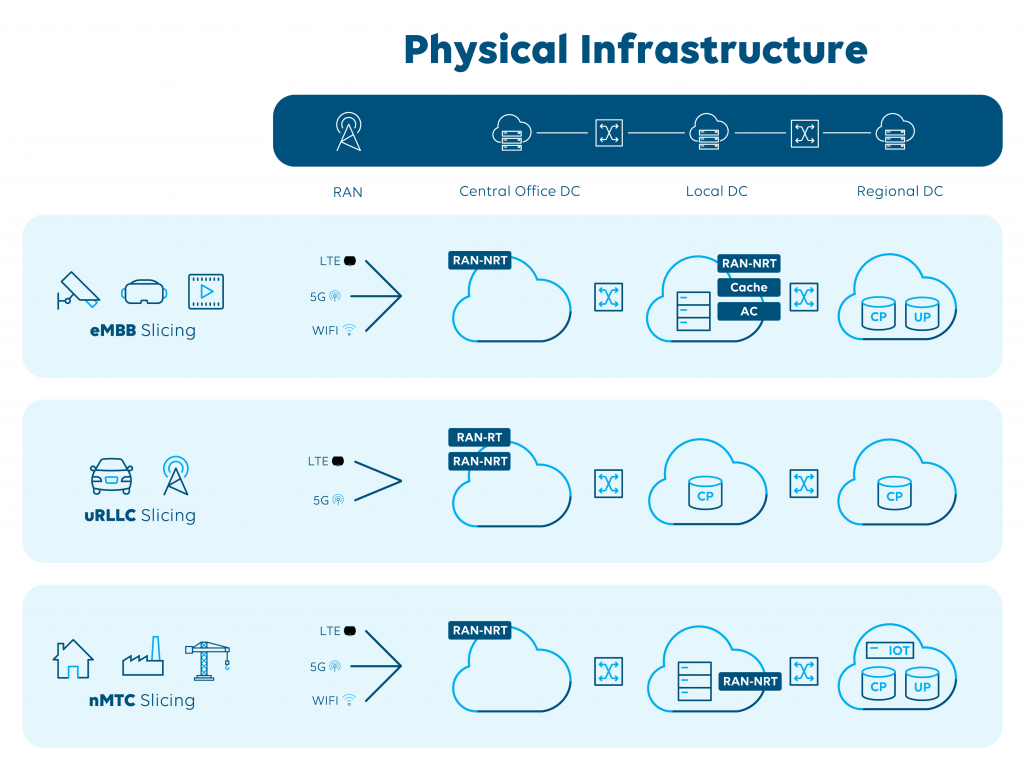Lately, initial rollouts of the fifth generation (5G) of mobile networks have been popping up all across the globe. But what exactly is 5G, and what are its differences compared to the previous generations?
What is 5G and what are its benefits?
The focus of previous generations was primarily on enhancing network capabilities and adding support for new services. 5G, however, aims to unify different network sectors and expand its ecosystem into new realms, such as industry, public transportation, and even healthcare.
5G envisions a holistic architecture with enhanced performance and highly dynamic traffic, while also taking into account the efficient management of all network resources. To that end, it offers dynamic mechanisms to flexibly adapt the underlying network to the traffic demands of different vertical scenarios (e.g. Industry 4.0, eHealth, etc.).
Network slicing: the answer to many challenges
To cope with all these architectural challenges, network slicing has been at the center of 5G studies. Network slicing uses Software-Defined Networking (SDN) and Network Function Virtualization (NFV) technologies to virtualize the core building blocks of the network. This enables the creation of communication system partitions for individual use cases: as network functions (NFs) are virtualized, they can be constantly (re-)instantiated in different cloud-based environments and network domains.
As illustrated in Figure 1 below, network slicing allows network resource sharing through the isolated provisioning of specific NFs allocated to disparate vertical deployments (i.e. network slices). For each network slice, only the traffic necessary for each use case should be taken into account, which means that not all slices will contain the same functions. This allows for more optimized usage of infrastructure resources.
In a nutshell, network slicing facilitates the sharing of a network across different services while tailoring its capabilities (e.g. speed, coverage, security, etc.) to the current usage needs.

End-to-end network slice orchestration
A slice orchestration system has to integrate several network blocks and dynamically manage end-to-end (E2E) slices, as illustrated in Figure 2. In light of this, DataMiner is developing the necessary mechanisms to leverage SDN, NFV, and management and orchestration (MANO) mechanisms to dynamically orchestrate network slices and periodically (or through publish/subscribe methodologies) monitor the network to (re-)instantiate, decommission, migrate and/or offload resources across the network.
In other words, DataMiner helps to abstract the instantiation of E2E network slices, which are composed of a chain of both physical and virtual NFs. By doing so, it becomes the central management and orchestration system, requesting network resources and coordinating the interaction among network orchestration entities—ranging from MANO and SDN controllers to RAN controllers—for its instantiation and chaining, which ultimately creates the E2E slice.
This extension with specific 5G integration mechanisms allows DataMiner to firmly position itself on the new 5G operations and monitoring market, while at the same time also affirming its position in the cloud and services integration segment.

Working towards open standards
Finally, infrastructure owners will continue to look for flexible ways to manage their networks through the application of SDN and NFV. This has sparked the attention of the O-RAN Alliance, a consortium of mobile network operators, vendors, and research institutions operating in the Radio Access Network industry.
To ensure interoperability among network components of different vendors, they propose to bring open standards to Radio Access Network (RAN) appliances. This effort from the different players within the industry will result in support for open and standardized interfaces in their RAN appliances. Agnostic platforms like DataMiner are therefore all the more crucial in the 5G space, ensuring a quick time to market for the various integrations.
You might also like
SOLUTION

Great post! Nice to see what’s upcoming when it comes to 5G and how to use DataMiner on this scope.
Great article! It’s really nice to understand how DataMiner can play a vital role in orchestrating and managing such complex systems.